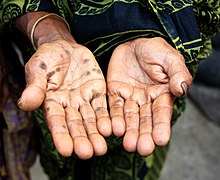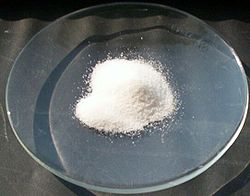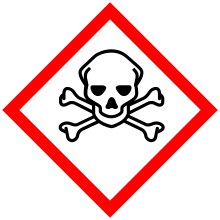Poisoning
This article may need to be rewritten to comply with Wikipedia's quality standards. (January 2022) |
This article needs additional citations for verification. (June 2019) |

Poisoning is the harmful effect which occurs when toxic substances are introduced into the body.[1] The term "poisoning" is a derivative of poison, a term describing any chemical substance that may harm or kill a living organism upon ingestion.[2] Poisoning can be brought on by swallowing, inhaling, injecting or absorbing toxins through the skin. Toxicology is the practice and study of symptoms, mechanisms, diagnoses, and treatments correlated to poisoning.[3]
Levels of Exposure[edit]
When a living organism is introduced to a poison, the symptoms that follow successful contact develop in close relation to the degree of exposure.[4]
Acute exposure[edit]
Acute toxicity/poisoning consists of a living organism being harmfully exposed to poison once or more times during a brief period, with symptoms manifesting within 14 days since administration.[5]
Chronic exposure[edit]
Chronic toxicity/poisoning involves a living organism being exposed to a toxin on multiple instances over an extended period of time, whereas the symptoms either develop gradually or after a protracted latent period.[6] Chronic poisoning most commonly occurs following exposure to poisons that bioaccumulate, or are biomagnified, such as mercury, gadolinium, and lead.[7]
Methods of Poisoning[edit]
Accidental poisoning[edit]

In 2020, America's Poison Centers' NPDS (National Poison Data System) report determined that 76.9% of recorded toxin exposures were accidental, with the rest of the statistics either being deliberate or unexpected.[9] A large portion of these accidental incidents occurred due to mistakingly taking the incorrect medicine, or doubling one's dose by mistake.[9]
Industry and Warfare[edit]

Nerve gases are synthetic substances used in industry or warfare that are specifically engineered to bring harm to living organisms.[10] They may paralyze a person in a matter of seconds or cease organ function, quickly resulting in death.They're considered to be biologically derived neurotoxins, which are a genre of toxic agents that act specifically against the nervous system. Inhaled or ingested cyanide (or Zyklon B) was used as a method of execution in gas chambers.[11] This method of poisoning instantly starved the body of energy by inhibiting the enzymes in mitochondria that produce ATP.[12] Intravenous injection of an unnaturally high concentration of potassium chloride, such as in the execution of prisoners in parts of the United States, quickly stops the heart by eliminating the cell potential necessary for muscle contraction.[13]
Pesticide exposure[edit]
Most biocides, including pesticides, are created to act as poisons to target organisms. Although acute or less observable chronic poisoning can also occur in non-target organisms (secondary poisoning), including the humans who apply the biocides and other beneficial organisms.[14] For example, the herbicide 2,4-D imitates the action of a plant hormone, which makes its lethal toxicity specific to plants. Indeed, 2,4-D is not a poison, but is classified as harmful.[15]
Toxication[edit]
Many substances regarded as poisons are toxic only indirectly through toxication. An example is "wood alcohol" or methanol, which is not poisonous itself but is chemically converted to toxic formaldehyde and formic acid once it's reached the liver.[16] Many drug molecules are made toxic in the liver, and the genetic variability of certain liver enzymes makes the toxicity of many compounds differ between people.
Precautionary Measures[edit]
| Poisoning | |
|---|---|
 | |
| Hazard Symbol (Pictogram) for Poisonning | |
| Specialty | Toxicology |
As mandated in GHS, various safety-orientated government agencies from around the globe have put into place the usage of pictograms when labelling toxic substances.[17][18] The hazard symbol which labels a substance as capable of poisoning depicts the imagery of a human skull in front of two bones crossing one another.[19]
GHS precautionary statements, which advise users to exercise caution or be aware of the substance's potentially dangerous features, are added to a legal toxins' labelling.[20] Toxic substances can also come with instructions on how to handle the product, what compounds to avoid mixing the product with, and how to treat a victim at risk of poisoning who has come in contact with the product.[21]
Various poison control centers are also available to assist in diagnosing, managing, and preventing possible incidents of poisoning.[22] Many are accessible through phone calls or official websites.
Treatment[edit]
Seeking medical attention is strongly advised if someone is thought to have been exposed to or consumed a poison, mainly from a nearby poison control centre.[23][24] It is advised to provide medical personnel with information regarding the poisoning, the patient's age, weight, and any other drugs they may be taking in addition to the symptoms of the illness. Try to determine what was ingested, the amount and how long since the person was exposed to it. If possible, have on hand the pill bottle, medication package or other suspect container.[25]
The treatment will depend on the substance to which the patient is exposed. Depending on the type of poisoning, some first aid measures may help. Treatments include activated charcoal, induction of vomiting and dilution or neutralizing of the poison.[26]
See also[edit]
- EPA list of extremely hazardous substances
- Lists of poisonings
- List of poisonous plants
- List of types of poison
- Toxicity
- Opioid epidemic in the United States
References[edit]
- ^ "Poisoning". medlineplus.gov. Retrieved 2021-10-26.
- ^ Cammack, Richard; Atwood, Teresa; Campbell, Peter; Parish, Howard; Smith, Anthony; Vella, Frank; Stirling, John, eds. (2006-01-01). Oxford Dictionary of Biochemistry and Molecular Biology (2 ed.). Oxford University Press. doi:10.1093/acref/9780198529170.001.0001. ISBN 978-0-19-852917-0.
- ^ "Toxicology". National Institute of Environmental Health Sciences. Retrieved 2022-12-05.
- ^ Calabrese, E.J. (2014), "Dose–Response Relationship", Encyclopedia of Toxicology, Elsevier, pp. 224–226, doi:10.1016/b978-0-12-386454-3.00991-x, ISBN 978-0-12-386455-0, retrieved 2024-04-09
- ^ Gold, Victor, ed. (2019). The IUPAC Compendium of Chemical Terminology: The Gold Book (4 ed.). Research Triangle Park, NC: International Union of Pure and Applied Chemistry (IUPAC). doi:10.1351/goldbook.at06800.
- ^ Elhag, Ibtihag Yahya (2023), "Role of AI in ADME/Tox toward formulation optimization and delivery", A Handbook of Artificial Intelligence in Drug Delivery, Elsevier, pp. 301–345, doi:10.1016/b978-0-323-89925-3.00011-3, ISBN 978-0-323-89925-3, retrieved 2024-04-15
- ^ Chojnacka, K.; Mikulewicz, M. (2014), "Bioaccumulation", Encyclopedia of Toxicology, Elsevier, pp. 456–460, doi:10.1016/b978-0-12-386454-3.01039-3, ISBN 978-0-12-386455-0, retrieved 2024-04-15
- ^ "Death rate from unintentional poisoning". Our World in Data. Retrieved 5 March 2020.
- ^ a b Gummin, David D.; Mowry, James B.; Beuhler, Michael C.; Spyker, Daniel A.; Bronstein, Alvin C.; Rivers, Laura J.; Pham, Nathaniel P. T.; Weber, Julie (2021-12-02). "2020 Annual Report of the American Association of Poison Control Centers' National Poison Data System (NPDS): 38th Annual Report". Clinical Toxicology. 59 (12): 1282–1501. doi:10.1080/15563650.2021.1989785. ISSN 1556-3650.
- ^ Patton, James. "Gas in The Great War". www.kumc.edu. Mail Stop 1025 3901 Rainbow Blvd. Kansas City, KS 66160: History and Philosophy of Medicine. Retrieved 2024-04-15.
{{cite web}}: CS1 maint: location (link) - ^ Stewart, Ken. "Zyklon-B | Description, Manufacturer, & Facts | Britannica". www.britannica.com. Retrieved 2024-04-15.
- ^ Jethava, Durga; Gupta, Priyamvada; Kothari, Sandeep; Rijhwani, Puneet; Kumar, Ankit (2014). "Acute cyanide Intoxication: A rare case of survival". Indian Journal of Anaesthesia. 58 (3): 312–314. doi:10.4103/0019-5049.135045. ISSN 0019-5049. PMC 4090999. PMID 25024476.
- ^ Simon, Gábor (2023-04-04). "Detection of Fatal Potassium Overdose: A Case Report and Review of the Literature". Diagnostics. 13 (7): 1339. doi:10.3390/diagnostics13071339. ISSN 2075-4418. PMC 10093193. PMID 37046560.
- ^ Kapeleka, Jones A.; Sauli, Elingarami; Ndakidemi, Patrick A. (2021-10-03). "Pesticide exposure and genotoxic effects as measured by DNA damage and human monitoring biomarkers". International Journal of Environmental Health Research. 31 (7): 805–822. Bibcode:2021IJEHR..31..805K. doi:10.1080/09603123.2019.1690132. ISSN 0960-3123. PMID 31736325.
- ^ Carvalho, Laíse M.; Soares-Filho, Antônio F.; Lima, Maciel S.; Cruz-Filho, João F.; Dantas, Taisa C. M.; Luz, Geraldo E. (February 2021). "2,4-Dichlorophenoxyacetic acid (2,4-D) photodegradation on WO3-TiO2-SBA-15 nanostructured composite". Environmental Science and Pollution Research. 28 (7): 7774–7785. Bibcode:2021ESPR...28.7774C. doi:10.1007/s11356-020-11085-4. ISSN 0944-1344.
- ^ Jones, A W. "Clinical and forensic toxicology of methanol". Forensic Sci Rev. Central Police University. PMID 34247144.
- ^ Boelhouwer, Eric; Davis, Jerry; Franco-Watkins, Ana; Dorris, Nathan; Lungu, Claudiu (September 2013). "Comprehension of hazard communication: Effects of pictograms on safety data sheets and labels". Journal of Safety Research. 46: 145–155. doi:10.1016/j.jsr.2013.06.001. ISSN 0022-4375.
- ^ "Globally Harmonized System of Classification and Labelling of Chemicals". www.canada.ca. 2023-03-21. Retrieved 2024-04-15.
- ^ "Know Your Hazard Symbols (Pictograms)". Office of Environmental Health and Safety. Retrieved 2024-04-15.
- ^ Vereinte Nationen, ed. (2007). Globally harmonized system of classification and labelling of chemicals: GHS (2nd revised ed.). New York: United Nations. ISBN 978-92-1-116957-7.
- ^ Vereinte Nationen, ed. (2011). Globally harmonized system of classification and labelling of chemicals: GHS. United Nations (4th revised ed.). New York: United Nations. ISBN 978-92-1-117042-9.
- ^ "Poison control center - PAHO/WHO | Pan American Health Organization". www.paho.org. 2021-01-14. Retrieved 2024-04-15.
- ^ "Poisoning Prevention | Child Safety and Injury Prevention| CDC Injury Center". www.cdc.gov. 2020-07-02. Retrieved 2020-11-28.
- ^ Yadav, Sharad; Shah, Gautam Kumar; Verma, Dharmesh; Yadav, Prakash Chand (2022-07-22). "Study of profile, pattern and outcomes of oral poisoning cases admitted in emergency department of Janakpur provincial hospital, Nepal". doi:10.5281/zenodo.6879818.
{{cite journal}}: Cite journal requires|journal=(help) - ^ "Poisoning: First aid - Mayo Clinic". www.mayoclinic.org. Retrieved 2021-10-26.
- ^ Avau, Bert; Borra, Vere; Vanhove, Anne-Catherine; Vandekerckhove, Philippe; De Paepe, Peter; De Buck, Emmy (December 2018). "First aid interventions by laypeople for acute oral poisoning". The Cochrane Database of Systematic Reviews. 12 (12): CD013230. doi:10.1002/14651858.CD013230. ISSN 1469-493X. PMC 6438817. PMID 30565220.
